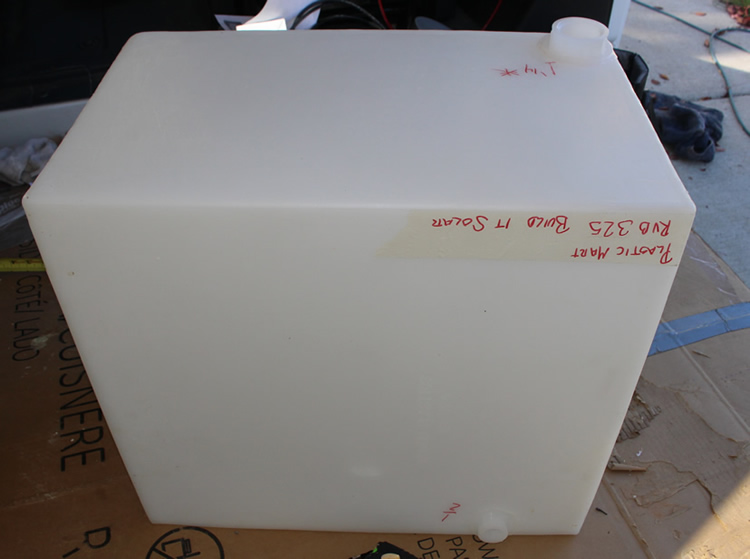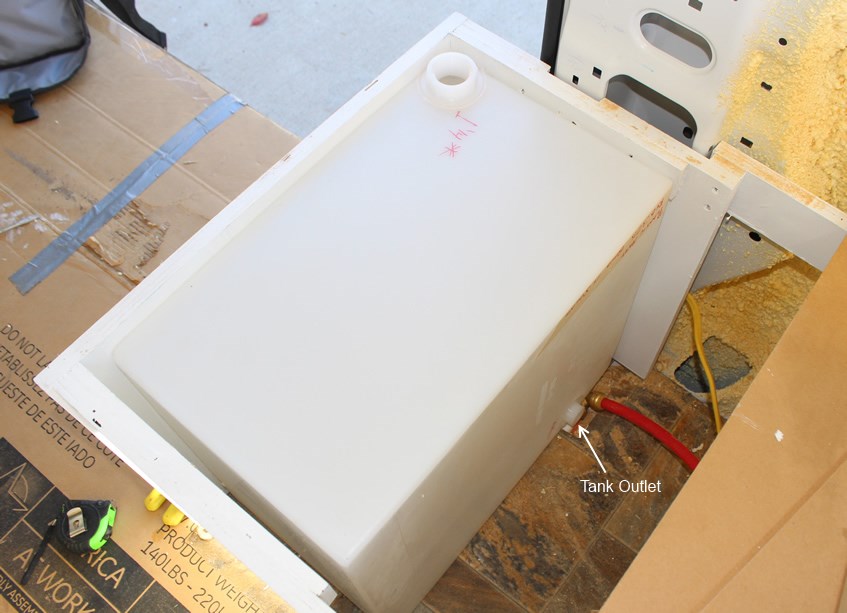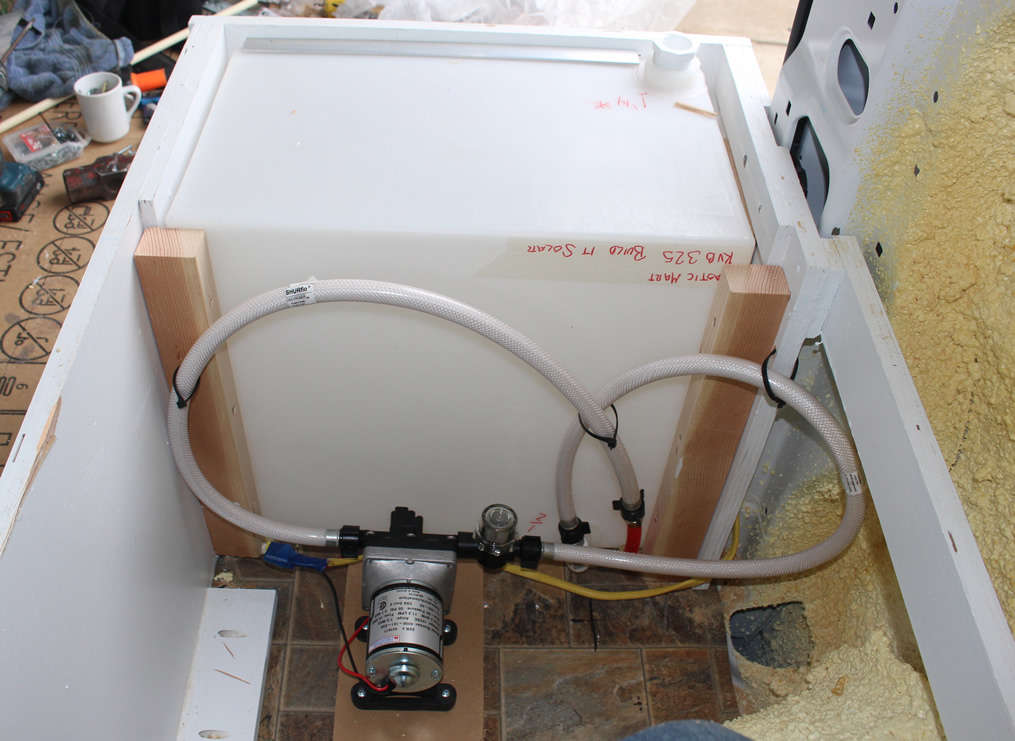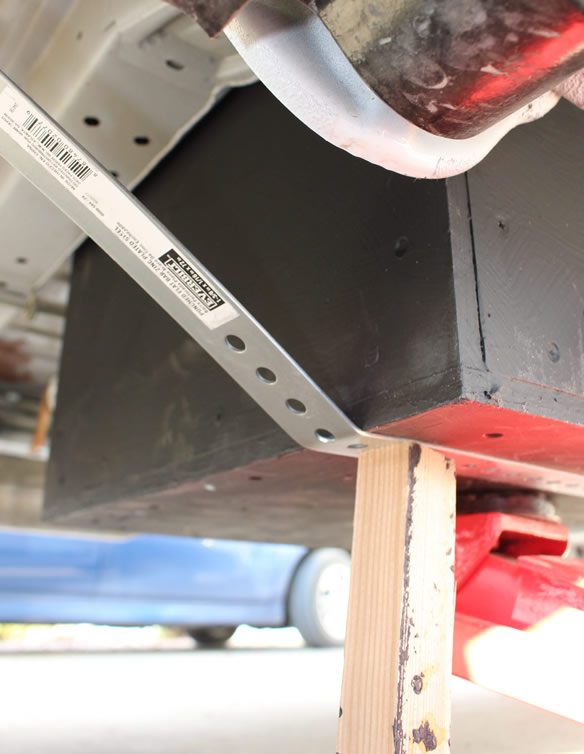
Search
The Renewable Energy site for Do-It-Yourselfers
ProMaster Camper Van Conversion -- Plumbing and the Fresh and Grey Water Tanks
| |
Important Update
The material on these pages describing our camper van conversion has been moved to our new new site dedicated to efficient RVs and camper vans.
The new site covers all the material here and adds a lot of new material on other camper van conversions, camper van design and build, resources for people converting vans, other efficient camping vehicles, new ideas in efficient RVs and camper van travel hints.
The new site is here...
I'm leaving these pages here as you may have bookmarked them and the Comments section has some good suggestions, but I suggest that you go to the new site -- I won't be updating this material anymore.
Thanks to all the people who read these pages and especially to the people who left comments and suggestions! Feedback on the new site is very much appreciated.
Gary
|
|
The van has a very simple plumbing system. The fresh water supply side consists of the 17 gallon fresh water tank, a 12 volt pump, and a single PEX line to the kitchen sink -- no hot water heater.
The grey water drain system consists of a drain from the kitchen sink to a grey water tank under the van, and an outlet to dump grey water overboard.
There is no toilet (blackwater) tank or drain as we plan to use a composting toilet, and there is no shower, although we might add an outside shower panel later at the back of the van depending on how things go.
Fresh Water System
The fresh water tank is from Plastic Mart. They offer quite a few sizes, and we were able to find one that fit our space well. They will install fittings in the tank where you want them and to the size you want. Ours has a 1 1/4 NPT thread fitting on the top for filling, and a half inch NPT fitting down low for drawing water out of the tank. The basic tank starts at what seems like a bargain $68, but by the time you add the fittings and pay the $50! shipping and handling, its up to $140 -- less of a bargain.
I don't have a vent fitting on the tank, and not sure what I will do about this -- maybe just leave the threaded plug on the filler fitting a bit loose? Update: Feb 2015 -- based on first trip, the leaving the filler plug a bit loose seems work fine.
The tank appears to be well made and has relatively thick walls.
The 17 gallon capacity is a bit on the small side as far as commercial RV's go, but the fact that we will have a composting toilet and not be using any of the water for toilet flushing makes the effective size of the tank quite a bit larger. We also don't have a shower. It also seems like potable water is pretty readily available in most areas. Update: Feb 2015 -- Based on the first week long trip, the 17 gallons appears to be fine.

The tank as it comes from Plastic Mart
Trial fitting the tank in place. It goes into the forward end of the passenger side bed. It fits well in that spot, and with the tank in this position, it can be filled by just opening the sliding door and running fill hose into the 1 1/4 inch filler fitting on the top -- no need for another hole in the van for an outside fill port.

The tank in position. The fill port is the large fitting on top. The water outlet for the tank is the small (1/2 inch NPT) white plastic fitting near the bottom. The red PEX line is going off to the galley on the other side of van (see floor section for routing).
Mounting the tank.
The tank is secured in place by the two blocks of wood (1 1/2 by 2 inches) you can see at the front of the tank. These are screwed to the bed box which is bolted through the floor. The aluminum angle iron across the front of the tank (which is screwed to the bed box) keeps the tank from moving upward in those pesky negative g situations. There are spacers on the right and left ends of tank that keep the tank from moving side to side.
Hooking up the pump:

The pump and plumbing around the pump.
The pump is a 12 volt DC Shurflo Revolution 4008. This is a 3 gpm pump that automatically turns off and on with demand. This model is supposed to be an improvement on the one that Shurflo has sold for years for RV that works but is fairly noisy and cycles a lot. The reviews I read indicate that the new model is a big improvement -- will see.
I also got the flexible hose kit and the strainer for the inlet that Shurflo recommended. The strainer keeps junk out of the pump, and the flexible hoses keep the pump from transmitting vibration (noise) to the van. The hoses just screw on to half inch NPT threads finger tight -- very quick to install. The pump mounting pad is rubbery to absorb vibration and noise.
The hose coming into the right (strainer side) of the pump is the from the tank outlet fitting, and the hose from the left of the pump is the outlet and goes to the one and only water use point in the van -- the sink on the other side.
The MDO plywood pad that the pump is screwed down to is just silicone caulked to the floor.
I used a few zip ties to keep the flexible hoses from wandering too far.
About $100 for the pump, strainer and hoses.
Grey Water Tank
The grey water tank is an experiment that may or may not work out. I made the tank from MDO plywood that I had left over from the beds. Its basically a glued and screwed box made from the MDO. MDO is Medium Density Overlay plywood -- its a premium plywood with resin impregnated face sheets on each side. One of its industrial uses is to make tanks, so maybe this will be OK.
Part of the reason I decided to go this way was just curiosity on how well it would hold up, but the other part is that is hard to find a plastic tank that fits the underside of the ProMaster and gives a descent volume without sticking down too far. I think that some of the commercial RV's remove the spare tire to make room for the tank, but we go on long gravel roads, and I don't want to be without a good spare.
The finished tank is 11 gallons (a bit less than I would like), and fits below the ProMaster leaving 10 inches of ground clearance -- the PM gas tank extends a bit lower than than the grey water tank.
The drain from the galley sink comes in high on one side of the tank, and the tank drain leaves low on the opposite side of the tank. The drain line is 1.5 inch PVC and has a ball valve to allow draining.
Left picture shows the finished tank mounted under the ProMaster with straps. The right picture shows the tank in the shop just before the cover was put on -- inlet on left and outlet on right.
Construction of Grey Water Tank:
The tank got two coats of Behr latex house paint inside and out. I don't think that the MDO requires much protection, but it does help to seal the unprotected edges.
In the end, the tank cost essentially nothing to build as all the materials were leftoovers.
Installing the Grey Water Tank:
These pictures show placing and securing the tank.

Pushing the tank up into place. It was a snug fit and took a bit of force to get it into place. |

Fit is snug -- I had to trim a little corner off the emergency brake bracket.
Top of tank sits up against the floor.
|

Important to get the straps really tight.
If the straps loosen over time, I'll drive a shim/spacer between the tank bottom and the strap.
|

The straps are secured to the frame cross members using three quarter inch screws at each strap location.
|
The straps are galvanized steel about 0.08 inches thick from Home Depot .
One negative for the MDO tank is that it weighs more than the poly tank -- The 17 gallon poly tank is about 12 lbs and the 11 gallon MDO tank about 20 lbs.
On the plus side, it probably is a bit more resistant to freezing and to rocks thrown at it by the tires.
Grey Water Plumbing
Sink to tank:
The only water coming into the grey water tank is from the galley sink. I used regular household plumbing supplies from Home Depot to make the connections.
The sink is a Houzer bar sink that they also sell for RV use. Also bought the Pfister G171 faucet set that Amazon offered along with the sink. Found out after the fact that Home Depot had a very similar bar sink, faucet and strainer combination availabe locally.

Picture shows the standard household sink plumbing down through the van floor. The only change I made was to go down to 1 1/4 PVC pipe at the floor level to make the pipe a bit easier to run under the van floor.
The sink is just temporarily set in place here to work out the plumbing. I'm waiting for the counter top laminate material to arrive before the permanent install. The galley cabinet will have a fridge in the big hole to the right, and drawers and cabinet doors for the rest -- waiting on materials to finish this up.
One thing I'd offer as a caution is make sure you have a good route for the drain pipe from the sink to the tank under the van. Its easy to locate the galley and sink, and then find that you can't find a good route for the drain pipe. For example, in the picture above, I would like to have pushed the drain pipe back close to the van wall, but there was just no way to do this give the way the van frame and the exhaust pipe ran.

The picture above shows the routing of the grey water line from the sink to the grey water tank under the van. The elbow in the foreground is coming down from the sink, and the 1 1/4 PVC line goes directly over to the top of the grey water tank. The bulge in the middle is a union that allows sink line to join with the tank line without having any space to slide the two pipes into a standard glued coupling -- also allows for easy removal of the tank down the line.
Update: Jan 2015 -- I had to add a vent pipe near the top of the tank to allow air to leave the tank as water drains into the tank and fills it. Without the vent tube, the water drained very slowely from the sink into the the tank. The vent is a piece of half inch PVC pipe that enters the tank righ near the top and just forward of where the "PVC Union" appears on the picture above. For now, this vent tube ends just a few inches outside the grey water tank and does not run up to the van roof or sidewall -- I may change this down the line, but it does appear to work OK as is.

Another view of the grey water pipe under the van. I added a piece of 4 inch aluminum HVAC duct over the PVC pipe and filled it with Great Stuff Pro foam to protect the PVC from potential overheat by the exhaust system. The Great Stuff Pro foam is approved as a fire block, so it should be OK for this, but will keep an eye on it. Also foamed the area where the PVC pipe goes up through the floor.
The PVC pipe has a slight down slope toward the tank so that there is no water accumulates in it.
Grey water tank drain out:

This shows the arrangement for draining the grey water tank. The 1 1/2 inch PVC line comes out near the bottom of the grey water tank and goes into a 1 1/2 ball valve. The line then continues on a little ways and terminates in a threaded 1 1/4 inch female fitting that has a 1 1/4 PVC plug screwed into it.
The support is made from one of the window cutouts and a standard 1 1/2 inch PVC pipe clamp. All Home Depot stuff. It feels VERY solid.
Will have to see if more protection from rocks kicked up by the tires is needed -- I do plan to add mud flaps on both front and rear tires.

This shows the drain hose arrangement. The hose is made for bilge pumps. The end of the hose is polyurethane glued into a 1 1/4 inch PVC threaded to slip adaptor. To use the hose, you just screw the hose and adaptor into the fitting on the end of the tank drain pipe and open the ball valve.
I used this unusual arrangement because I do not like the bulky hose used on most RV's, and the bad experiences I've had in the past with the regular RV dump plumbing and valves. I think I can cut off most of the length of the bilge pump hose, but will wait to see how it works out in practise.
For areas that allow it, a bucket or the like could be placed under the drain pipe and the ball valve left open. In the morning, just empty the bucket in the approve area.
Cost and Weight
The installation of the fresh water tank took about an hour with another hour to install the pump.
Making the grey water tank was about 3 hours, with some breaks for paint and sealer to dry.
Installing the grey water tank took about 2 hours.
The grey water plumbing was about 3 hours.
That totals to about 10 hours -- probably more like a couple full days.
| Item |
Cost |
Weight |
| |
|
|
| Fresh Water Tank |
$139 (incl $50 shipping) |
12.3 lb |
| Pump |
$101 (with strainer and pipes) |
2 lb ? |
| PEX Plumbing run |
$10 ? |
3 lb ? |
| Grey Water Tank |
$0 |
20.7 lb |
| Grey Water Plumbing |
$20 ? |
4 lb? |
| |
|
|
| |
|
|
After Thoughts
We did consider a water system that just used 5 or 6 gallon plastic "jerry" cans. Some conversions have used these successfully, and I'm not sure that overall it would not be quite satisfactory. You can get submersible pumps that go right into the 5 gallon plastic can and provide water to a sink faucet. The drain water from the sink just goes into another poly can, which might be located outside the Van.
I think that its good to consider this simple approach, and see if it works out well for your situation.
On the plus side, the jugs solution is a really simple solution and saves a lot of install work, but on the negative, it take up space in the galley cabinet, and limits the amount of water you can carry.
I'd be happy to hear any ideas, suggestions, corrections, or questinons -- use the Comments link just above.
Gary
October 1, 2014

